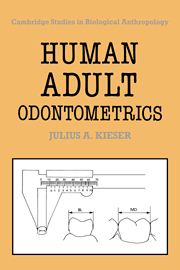Book contents
- Frontmatter
- Contents
- Foreword
- Preface
- 1 Introduction
- 2 Measurement of tooth size
- 3 Inheritance of tooth size
- 4 Comparative odontometry
- 5 Odontometric trends
- 6 Sexual dimorphism in tooth size
- 7 Odontometric variability
- 8 Compensatory tooth size interactions
- 9 Fluctuating odontometric asymmetry
- 10 Allometric relations of tooth size
- Odontometric appendix
- References
- Index
8 - Compensatory tooth size interactions
Published online by Cambridge University Press: 05 February 2012
- Frontmatter
- Contents
- Foreword
- Preface
- 1 Introduction
- 2 Measurement of tooth size
- 3 Inheritance of tooth size
- 4 Comparative odontometry
- 5 Odontometric trends
- 6 Sexual dimorphism in tooth size
- 7 Odontometric variability
- 8 Compensatory tooth size interactions
- 9 Fluctuating odontometric asymmetry
- 10 Allometric relations of tooth size
- Odontometric appendix
- References
- Index
Summary
Introduction
Hominid dentofacial reduction has been a topic of major research during the past hundred years or more. The problems posed by the differential reduction of tooth size and jaw size are complex and raise issues of ontogenetic, phylogenetic and clinical significance. Although it is sometimes asserted that the challenges posed by phylogenetic facial shortening are difficult to relate to empirical orthodontic research, there are in fact a number of points of contact between the two fields of investigation. The object of this chapter is to review one such contact point: that of compensatory interactions between adjacent teeth, in the face of spatial restriction, first by considering the variability of the upper incisors, and then by considering Sofaer's model of compensatory tooth size interaction.
Upper incisor interactions
The theory that human upper lateral incisors, like wisdom teeth, are particularly susceptible to reduction in size, grew out of early attempts to reconcile the progressive shortening of the jaws with a concomitant but less dramatic reduction in tooth size (e.g. Rosenberg, 1895; Wiedersheim, 1895; Rose, 1906; Hrdlička, 1911). This traditional picture was, however, shattered by Ashley-Montagu (1940) who argued that if the upper and lower jaws had undergone an equal reduction there should be an equal reflection of this in the teeth of both jaws. Accordingly, the mandibular incisors would be expected to be affected at least as often as those of the upper jaw.
Ashley-Montagu sought to demonstrate that upper lateral incisor variability in man was related to premaxillary rather than dental reduction.
- Type
- Chapter
- Information
- Human Adult OdontometricsThe Study of Variation in Adult Tooth Size, pp. 89 - 95Publisher: Cambridge University PressPrint publication year: 1990



